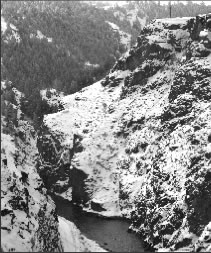by John Orr
Gunnison River flow regime through Black Canyon
Last year, conservationists, irrigators, the National Park Service, the Bureau of Reclamation, the state of Colorado, along with many other groups and municipalities, sat down and hammered out an agreement to manage flows in the Gunnison River through the Black Canyon. The agreement was the outcome of a 2006 lawsuit by environmental groups to overturn a 2003 back room deal between the Department of Interior and the state of Colorado. The original deal called for minimum flows in the national park of 300 cfs with no consideration for larger flows or shoulder flows to help maintain riparian health or for restoration. As a result of the lawsuit federal Judge Clarence Brimmer threw out the agreement terming it, “nonsensical.”
Colorado Trout Unlimited’s Drew Peternell remarked, “The deal flatly ignored the science,” according to the Rocky Mountain News.
Last June, Chris Treece (Colorado River District) said, “The agreement does represent less water than the National Park Service had applied for — it was more than the river carried — and more than the [original] agreement that the state negotiated… it has all the elements of a compromise,” according to the Grand Junction Daily Sentinel. The agreement is tied to snowfall and runoff and does not recreate the natural hydrograph, but is a lot closer than the way the river has been managed for the last 30 years.

As we go to press, flows in the Gunnison through the canyon should be around 6,000 cfs. Reclamation is planning on the increased flows for 10 days or so. “With these renewed flows, the Gunnison River through the Black Canyon will experience a rebirth, and its priceless natural resources will be safeguarded for generations to come,” said Peternell in a release on May 7.
San Luis Valley groundwater
Compliance with the Rio Grande Compact, protection for senior surface rights holders and the encouragement of groundwater sub-districts are driving efforts in the San Luis Valley to work out rules for pumping groundwater.
Earlier this year State Engineer Dick Wolfe put together a 56 member advisory committee hoping for a bottom-up solution to curtail groundwater pumping. The committee held its first meeting in March. “We want to look for the common interests,” Wolfe told the group, according to the Valley Courier.
Sustainability of the aquifers and surface water systems are unique to the Rio Grande Basin according to Wolfe. Everyone involved is hoping to avoid forcing well owners to shutdown involuntarily as has happened in the South Platte, Arkansas and Republican river basins.
The other big groundwater issue is the trial over the management rules for the Valley’s first groundwater sub-district. Judge O. John Kuehold has been walking the sub-district’s board of managers and their attorneys through a rewrite of the original rules which were laid out in 2008. The primary goal of the rules is to reduce groundwater irrigated farmland by 40,000 acres.
Early in May Kuenhold moved the August 3 trial date to September 28 to allow more time for review prior to giving public notice. This leaves little time for supporters of the rules to get tax information to Alamosa, Rio Grande and Saguache county assessors by December 1. That’s the deadline if the sub-district intends to collect tax revenue for operations in 2010.
Nestlé Waters North America Chaffee County Project
Nestlé’s plans to move 200 acre-feet or so of water out of basin to Denver for bottling is still very much in the news around central Colorado.
Proponents have started fighting back against objections. According to The Mountain Mail, Nestlé relied on water attorney Steve Sims to present their side at the fifth session in front of the Chaffee County Commissioners. The augmentation plan — using water leased from the city of Aurora — has been a bone of contention lately. Sims reported that since the Aurora water would come from upstream of the Nestlé site that instream flow issues would be less of a concern. He also reported that Aurora’s water comes from the Twin Lakes project and therefore is out of basin water. (Readers may remember that the Arkansas Basin is both an importer and exporter of water.) Sims also stressed that the volume of water can easily be covered by Aurora with the addition of the city’s Prairie Waters reuse project on the South Platte River below Denver, where the city is recovering out of basin water that can be used to extinction.
Nestlé’s consultants, THK Associates, presented financial data at the same meeting. Current plans indicate that Nestlé will pay $2.3 million for project labor and $4.8 million for materials. The installed properties will add $500,000 to Chaffee County tax rolls over the next 30 years. They’re also footing the bill for costs for the permits and setting up a $500,000 community endowment.
Short takes
• Mount Princeton Geothermal is currently testing the geothermal potential in the area near the Mount Princeton chalk cliffs. If they can prove that their site contains water non-tributary to surface water they hope to build an electrical generation plant.
• Fremont County Commissioners are less than enthusiastic at the news that Cotter Corporation plans to reopen their uranium mill near Cañon City despite the plume of pollution in the groundwater that is still not contained.
• The South Park Heritage Area was included in the omnibus public lands package signed by President Obama in March. The bill also included the Sangre de Cristo National Heritage area, the Baca Wildlife Refuge Management Act and the Great Sand Dunes National Park and Preserve Act. The latter two bills are an effort to restore, enhance and maintain wetland and riparian habitats and protect fish species.
• Congratulations to Gunnison resident John McClow who was named to the Colorado Water Conservation Board by Governor Ritter.
• Congratulations to Carl Genova. He received the annual Bob Appel Friend of the Arkansas River award at this year’s Arkansas River Basin Water Forum.
• John McMichael and Conifer Water LLC have run into regulatory snags for the proposed pipeline from Bailey to Conifer. They still need a 1041 permit from Park County and approval for the diversion from the U.S. Army Corps of Engineers. The pipeline is actually two pipelines, one for supply to the Conifer area and one for return flows from the treatment plant back to the South Platte.
• Trout Unlimited turns 50 this year.
• Governor Ritter signed H.B. 09-1233 into law on April 23. The bill recognizes the historical nature of acequias and encourages their continued operation. Freshman State Representative Ed Vigil was the force behind the bill.
• The governor signed S.B. 09-080 on April 22. The bill allows limited rainwater catchments for properties that already have a water supply well that is exempt from state regulation due to little or no impact on senior rights holders.
• The Lower Arkansas Valley Water Conservancy District is exercising it’s option to purchase shares of the Larkspur Ditch. The ditch brings water from the Gunnison Basin into the Arkansas Basin.
• Don’t forget to register for the Colorado Foundation for Water Education’s annual river basin tour at cfwe.org. This year they’ll be touring the Rio Grande Basin.



